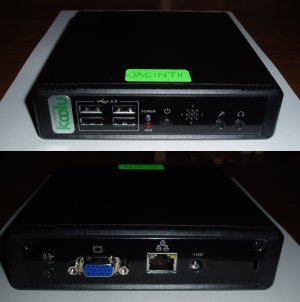| What is it? | Justify | Functions | On Desktop | Details | Installation | Top |
Web links:

Koolu's primary mission is to provide thin client
hardware to
business clients and to consult with them to get the client-server model
working. I didn't do much research into their recent history, but their
web page indicated that recently they have had a business model realignment
such that their hardware is now made by First International Computer under
the name Mini PC Ion A603
, and this product may soon be sold under
the Everex brand name in North America.
The Ion A603 as provided by Koolu includes these subsystems:
CPU: AMD Geode LX 800 @0.9W. This chip uses the i586 family instruction set (not i686), with hardware floating point. Nominal clock speed is 500 MHz. See here for benchmarks and speed tests. Typical power use (per the family product page) is 1.8 watts; 3.6 watts max. Power measurements are given here. The southbridge (connection to peripheral devices) is the CS5536 Companion Device.
Memory: 512 Mbytes DDR2 SDRAM, factory installed. 256 Mb or 1 Gb are available as options; 1 DIMM of 1 GB is the maximum that the motherboard supports.
Disc: Koolu offers an optional 80 Gbyte internal disc in the Network
Appliance
configuration. The Thin Client
, which is what I got,
includes everything but the disc. Everything
means the disc tray
(equivalent to rails in a desktop machine), vibration isolation grommets,
mounting screws, and a PATA cable that will fit. Physically you can install
any standard laptop drive, but there is a
capacity limit in the BIOS -- and a
workaround for it.
The physical protocol is UDMA/100. The motherboard does not support SATA.
I bought my own disc separately, a
Seagate Momentus
ST9160821A 160 Gb laptop drive.
See here for how to install it.
One can also get a flash memory device that emulates a disc and mounts
onto the PATA pins. Other possibilities are to boot from a USB external
disc or a USB flash memory device that emulates a disc.
USB: There are four USB-2.0 host ports on the front panel. AMD Geode documentation says that one could be configured as a device port, but I have not seen any instructions for how that might be done. (It could be useful on a handheld device, but the Koolu would normally take the host role.) The hub uses the ohci_hcd driver (UHCI is typical on Intel chipsets) plus ehci_hcd, and client devices use their normal drivers.
Network: There is one RJ45 jack for IEEE 802.3 Ethernet at 100 MHz. It uses the RealTek RTL8139 chipset and the 8139too driver.
Sound: The CS5536 Companion Device includes an AC'97 type sound device, controlled by the snd_cs5535audio ALSA driver. There are stereo outputs on both the front and rear panels, and a microphone input.
Video: The Geode LX chip includes a video device with extensive
capabilities, which is served in the Xorg-X11 server by the amd
driver. See here for details about the video.
Output is via a VGA connector.
Locking: There is a Kensington lock slot in the back panel, for theft resistance in public areas.
Cooling: There is no fan; it is natural convection cooled through the aluminum case. It would be a good idea to allow air circulation and not to stack other equipment or stuffed animals on top of the case. At 20 C ambient temperature the case is warm to the touch, perhaps 35 C. The disc drive reports internal temperatures at two different places of around 40 and 60 C. I was not able (yet) to discover how to read out the CPU temperature; ACPI does not reveal it, or anything else.
Other vendors sell this product also, or at least vendors' photos appear identical, but the configurations and shipping contingencies seemed to me to be less favorable than Koolu's.
The Koolu hardware is priced in Canadian Dollars. Payment at the online store is handled by Paypal, and they take American credit cards (as well as Paypal accounts); currency conversion will be handled by the card company for a small fee.
Unfortunately when I decided to buy the Koolu they were serving what their website described as a large order that would cause shipment delays by up to five weeks. Indeed, it took four weeks for them to ship my machine, but it did arrive. It's good that they keep their website updated with current company information.
Shipping to the USA is by Xpresspost USA, a service of Canada Post. Last
kilometer
delivery is by the United States Postal Service. They delivered
quicker than their service standards, in 5 calendar days or 3 business days. A
signature is required for delivery. Somehow, even with NAFTA, international
shipping is always either expensive or outrageous; this service is one of the
more reasonable ones.
| What is it? | Justify | Functions | On Desktop | Details | Installation | Top |